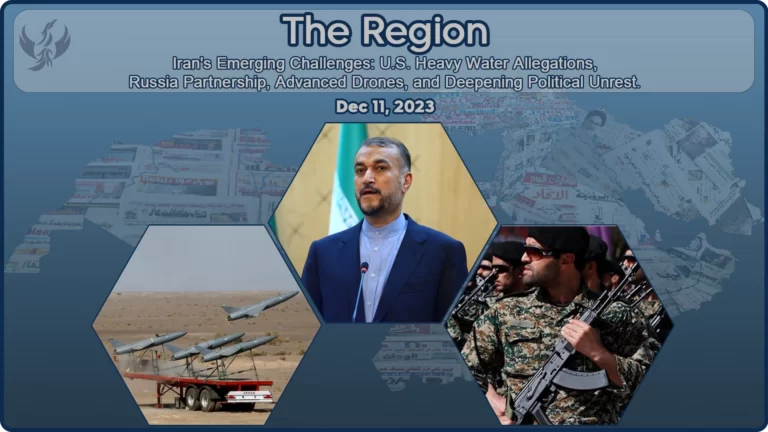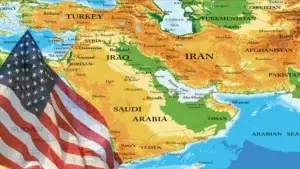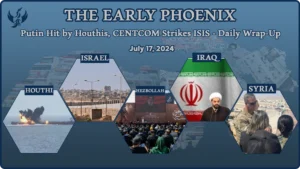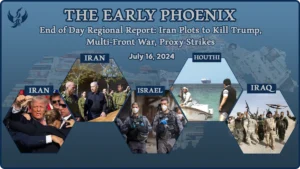By: Rania Kisar
Iran’s Emerging Challenges: U.S. Heavy Water Allegations, Russia Partnership, Advanced Drones, and Deepening Political Unrest.
-
Is the U.S. Buying Iranian Heavy Water?
Last week, the United States imposed sanctions on 13 individuals and entities accused of transferring tens of millions of dollars from the sale of Iranian commodities to the Houthi group in Yemen.
Following this, Iran’s Foreign Minister, Hossein Amir-Abdollahian, revealed allegations that the United States had procured Iranian heavy water despite the sanctions. He noted that this indicated a failure of the United States to adhere to its own sanctions on Iran. Amir-Abdollahian also highlighted a stalemate in discussions about the nuclear agreement, hinting at a potential escalation in Iran’s nuclear capabilities.
Further intensifying tensions, Amir-Abdollahian warned of an “uncontrollable explosion in the region” following the U.S.’s veto of a Security Council resolution calling for an immediate ceasefire in Gaza. Echoing this sentiment, Iran’s foreign ministry spokesman Nasser Kanaani condemned the sanctions as biased, designed to shift focus from Israeli actions in Gaza. Kanaani asserted Iran’s right to take reciprocal measures and accused Western countries, including the US, UK, and Canada, of double standards in human rights due to their support for Israel.
-
Cyber Pacts and UAVs: The Evolving Russia-Iran Partnership.
Russian President Vladimir Putin and his Iranian counterpart, Ebrahim Raisi, recently met to discuss various geopolitical issues, signaling a strategic partnership that extends Russia’s global alliances. This meeting, also focusing on energy and counteracting Western sanctions, raises concerns over Russia’s support for Iran’s regional activities. Concurrently, Iran strengthens its cyber cooperation with Russia, causing Western alarm over potential cybersecurity threats.
Further complicating matters, Ukraine’s Prosecutor General’s Office has identified Iran’s HESA as the producer of kamikaze UAVs used by Russia in Ukraine, the first official indication of Iran’s involvement in UAV manufacture. This forms part of Ukraine’s broader investigation into drone origins. With HESA known for both military and civilian aircraft production, Ukraine is bracing for intensified drone warfare by Russian forces.
Adding a new layer to Russian-Iranian dynamics, a recent phone call between Israeli Prime Minister Benjamin Netanyahu and Putin highlighted Israel’s concerns over Russia’s growing ties with Iran and its stance on the Israel-Hamas conflict. Netanyahu criticized Russia’s UN representation for its anti-Israel positions and warned of the perils in Russia-Iran cooperation. Meanwhile, the leaders also discussed the Gaza humanitarian crisis, with Putin expressing concern for civilians and Netanyahu urging Russian influence on the Red Cross for better hostage access. Putin maintained Russia’s anti-terrorism stance but emphasized civilian protection in counterterrorism, and Russia proposed an international mission to assess Gaza’s humanitarian situation, underscoring its active role in regional affairs.
-
Karar Drones: Iran’s New Long-Range Arsenal.
Another notable development in Iran’s military capabilities is the enhancement of its Karar drones. These drones have been armed with Majid air-to-air missiles and have a reported range of 1,000 kilometers. This upgrade represents a strategic shift in Iran’s defense posture, providing a cost-effective alternative to aging manned aircraft. The drones’ ability to track targets using thermal and visual methods enhances Iran’s capacity to counter various aerial threats, including unmanned drones.
-
Cracks in the Regime: Iran’s Political Unrest Deepens.
In Tehran, the undercurrents of political unrest are becoming increasingly visible. Supreme Leader Ali Khamenei grapples with fears of defection and internal discord within his regime, amid concerns of a popular uprising. The Gaza conflict, perceived by Khamenei as a stabilizing factor, has not quelled the growing unease among Iran’s top brass. Amir-Ali Hajizadeh of the IRGC voices worries about waning loyalty, underscoring the need for unwavering revolutionary zeal.
A refinery fire in Iran’s Birjand special economic zone led to two explosions and remains uncontrolled, according to state media. The fire, which initially engulfed 1.5 million liters of fuel, has spread to all 18 reservoirs at the site. While no casualties have been reported, the extent of the damage is still unknown.
Meanwhile, President Ebrahim Raisi and Parliamentary Speaker Mohamad Bagher Ghalibaf publicly dismiss rumors of a rift, yet the media affiliated with each camp tells a different story. Judiciary Chief Gholamhossein Mohseni Ejei’s recent comments about a financial corruption case have only added fuel to the fire, exposing further cracks in the regime’s facade.
Iranian authorities have accused Swedish EU diplomat Johan Floderus, detained in Tehran for over 600 days, of espionage and collaboration with Israel. Charged with “extensive intelligence cooperation” and “corruption on earth,” a capital offense in Iran, Floderus was arrested amid the trial of Iranian national Hamid Noury in Sweden for 1988 mass executions. His arrest coincides with strained Tehran-Stockholm relations following the execution of Iranian-Swedish dissident Habib Chaab and the ongoing death sentence threat to Ahmadreza Djalali. The EU and Sweden have called for Floderus’s immediate release, denouncing the charges. This development occurs amidst deteriorating EU-Iran relations, influenced by Iran’s alleged drone support to Russia in Ukraine and its response to internal protests.
Adding to Iran’s woes, UN Special Rapporteur Javaid Rehman has condemned the brutal treatment of the Baluch minority. In a recent London address, Rehman highlighted the disproportionate impact of the “Woman, Life, Freedom” protests on Baluch and Kurdish communities, with children bearing the brunt of the violence. The Baluchis, primarily Sunni Muslims in the Sistan-Baluchistan province, have long suffered persecution and high execution rates. Amnesty International corroborates this grim reality, ranking Iran among the highest in global execution rates.
===================




